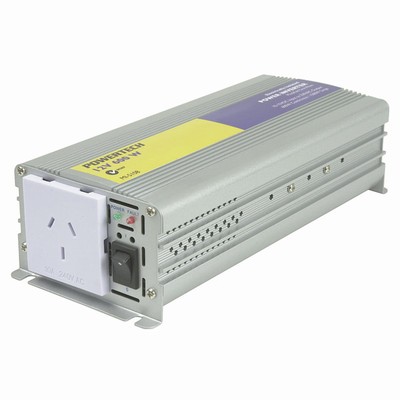Inverters

A typical power inverter
Having solar panels to generate electricity and charge batteries through a charge controller is a great thing, but normal home appliances cannot be powered directly from DC electricity in nearly all cases. Unless you only plan to use DC lighting and DC-capable appliances, an inverter is a must.
How they work
An inverter takes 12v (or 24v, sometimes 48v, depending on the inverter) and converts it into 240V AC, for use by normal home appliances.
The most basic inverter will have: Positive and negative terminals for connection to a battery; power (on/off) switch; an AC outlet with a socket to allow appliances to be plugged in; and generate 'modified sine wave' .
More expensive inverters have auto-start, produce a pure sine wave output and have remote control facilities.
Modified or Pure Sine Wave?
The AC power supplied from the grid is a pure sine wave. That is, the voltage will swing smoothly from positive 240 volts, through zero, then negative 240 volts, through zero again, and back to positive 240. It does this 50 times a second (or 120 volts at 60 Hz for North American countries).
Most of the lower end (entry-level) inverters produce a so-called 'Modified Sine Wave'. This is actually similar to a square wave, but with the voltage staying at zero for part of the time (instead of switching directly from +/- 240 volts). By doing so, it crudely approximates a sine wave.
Modified Sine Wave inverters are substantially cheaper than Pure Sine Wave inverters.
When to use Modified Sine Wave inverters
Any appliance with a standard switchmode power supply (e.g. Laptop computer), and resistive load appliances (e.g. incandescent lamp, electric toaster) can be powered safely from a modified sine wave inverter. There may be a slight buzz to be heard from the appliance, but this is normal and will not harm the equipment.
When to use Pure Sine Wave inverters
Modified sine wave inverters can be quite efficient for some appliances, but can cause erratic operation and low efficiency for those that expect a pure sine wave. This is especially true for appliances that present an inductive load, such as motors.
Many older computer switchmode (switching) power supplies will very happily accept a modified sine input. However, newer computers that incorporate Power Factor Correction (PFC) circuitry in their power supplies may not work, and even if they do, can emit a loud buzzing sound. The PFC circuitry can also cause undue heating and stress on a modified sine wave inverter. Active PFC circuits are much more troublesome than passive PFC.
Radios and HiFi systems (especially amplifiers) are quite succeptible to the noise produced by a modified sine wave inverter, and will result in a 100 or 200Hz buzz emanating from the audio output. A pure sine wave inverter is a must if you intend to power such equipment from solar power.
See also: Inverter Types.
Grid Tie Inverters
Generally speaking, grid tie inverters (GTIs) are mostly within the realm of commercially installed solar PV systems, ranging from 0.5 kW through to 10 kW.
For the DIYer, whose systems will be much smaller, less hefty GTIs are used. These are called micro-inverters, owing to both their dimished size and capacity. Most micro-inverters are simple plug-in units, without the need for professional installation.
See review: Power Jack PSWGT-300
Info on Aero-Sharp inverters.
